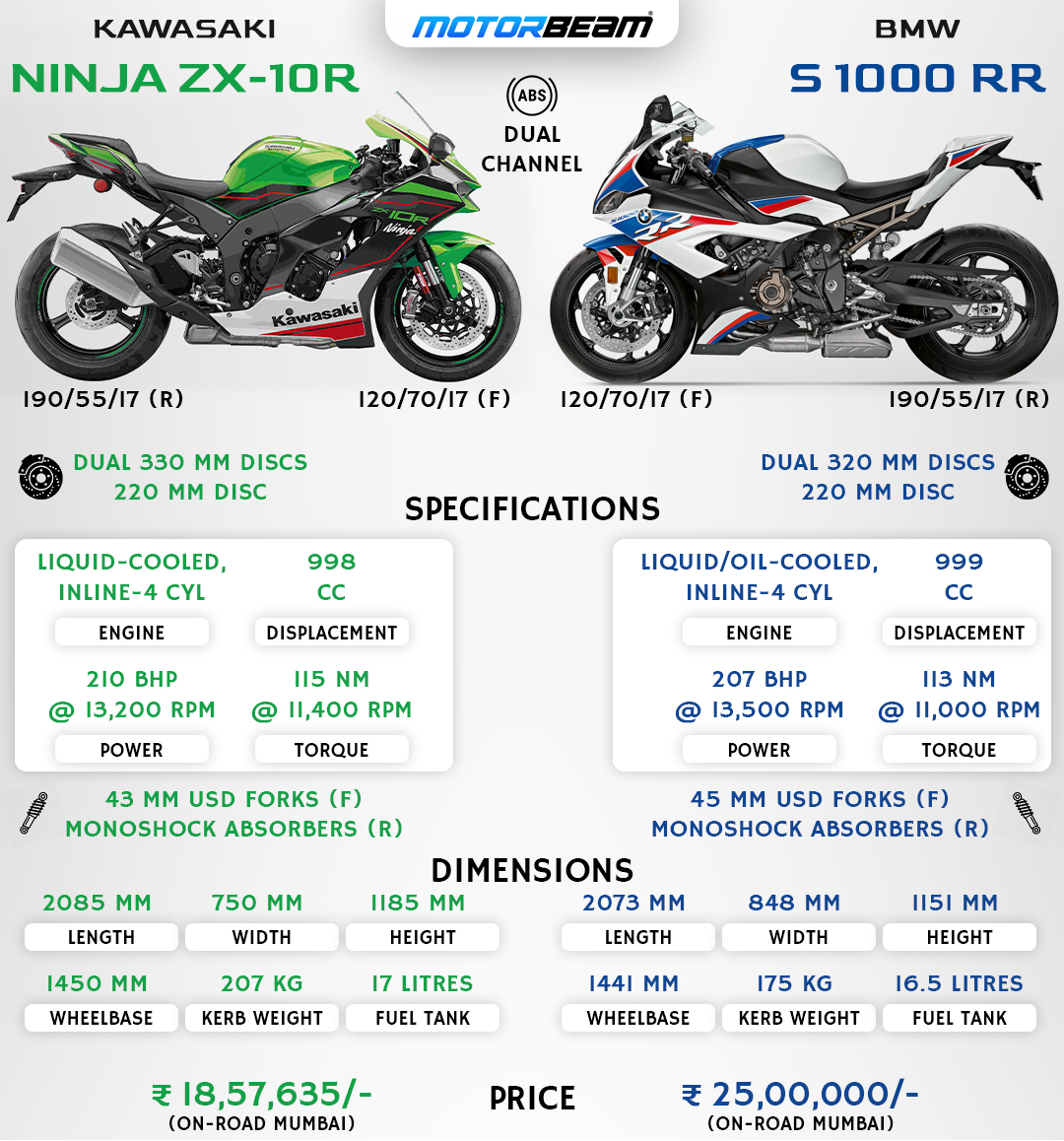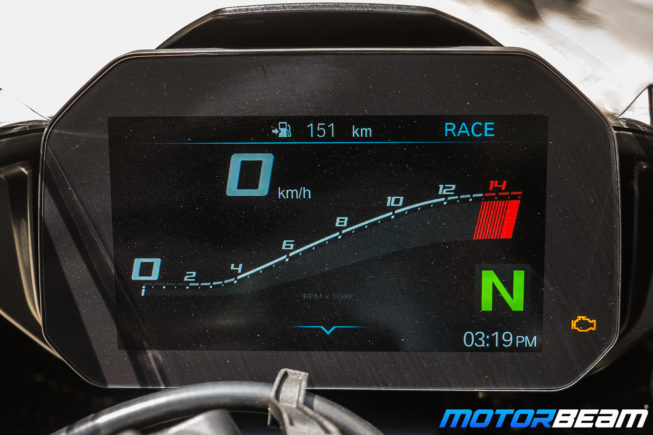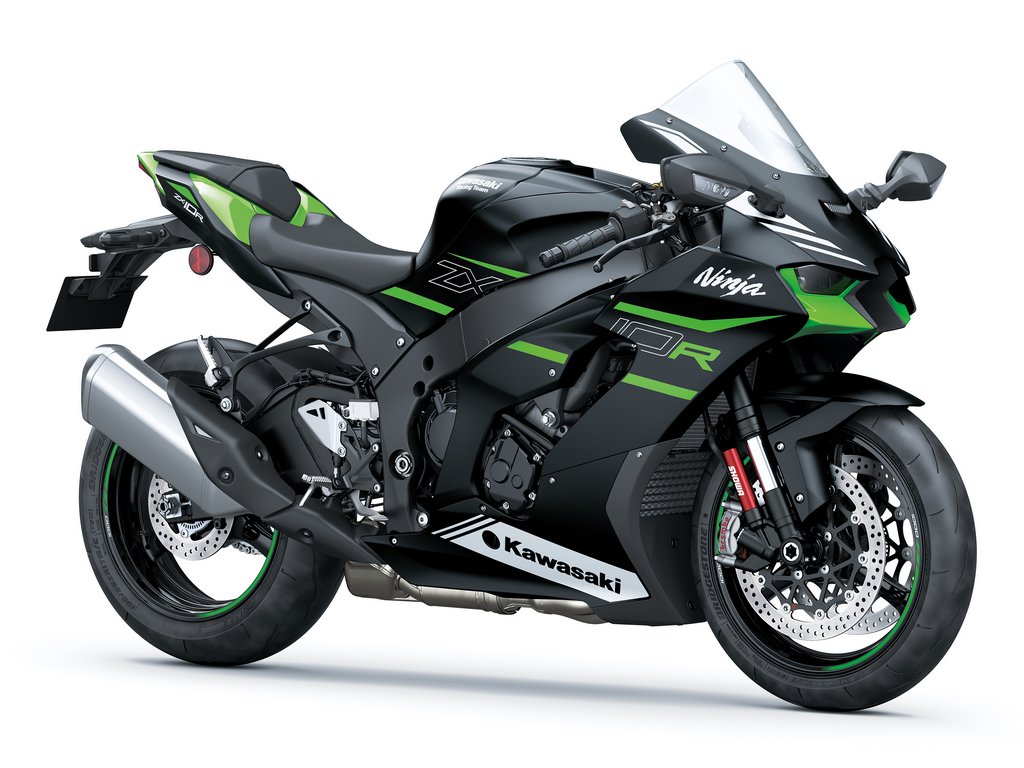Kawasaki Ninja ZX-10R vs BMW S 1000 RR – Spec Comparision
Most detailed spec comparison of the Kawasaki Ninja ZX-10R and BMW S 1000 RR
Most detailed spec comparison of the Kawasaki Ninja ZX-10R and BMW S 1000 RR
Home » Bike News » Kawasaki Ninja ZX-10R » Kawasaki Ninja ZX-10R vs BMW S 1000 RR – Spec Comparision

Kawasaki recently updated their latest iteration of the Ninja ZX-10R inspired by their SBW championship; they have loaded the 10R with a host of features. The electronics ensure that the rider can enjoy their weekend rides and their weekly track runs to have the fun of both worlds. On the other hand, BMW is also not behind, having upgraded its motorcycle in 2019. The Ninja now provides creature comforts like cruise control, but the BMW S 1000 RR is still the only superbike that offers features like cruise control and heated grips from its inception. This time, we pit the Japanese and the German super sports against each other in a spec comparison to see which one is worth it.
Talking about the Ninja, the design language is now purpose-built. The winglets integrated into the front upper cowl add to the looks and also create downforce while accelerating hard. The white colour strip with Kawasaki written on it near the belly area gives it a racier look. The 10R now is offered in two colour options; green and black, whereas the BMW gets three colour options; motorsport, metallic silver, and metallic black. The Ninja’s fascia now houses a new LED headlamp and an air-intake, in between which is a ram-air unit. It also gets the Kawasaki’s River mark logo upfront which is on the H2.
The S 1000 RR here looks like a meaner machine than before. Surprisingly, the new headlamp with its symmetrical design seems odd as we had the asymmetrical headlamp grow on us since its inception. The BMW seems to be more tightly packed and looks pretty compact. The exposed frame also gives it a sportier feel. From the front, if you notice, the indicators are now moved from the fairing to the mirrors, giving it a more aesthetic look. At the rear, BMW has integrated the tail light into the side indicators, to have a cleaner look. Both have had a major change in the design department, which one do you feel looks better now?
When it comes to features, both motorcycles are loaded to the brim. The Kawasaki is equipped with a 4.5-inch color TFT display, but on the contrary, BMW still has a bigger screen at 6.5-inch similar to its GS siblings. Ninja also offers four riding modes, launch control, cruise control, traction control, a bi-directional quick-shifter, and the list goes on. It also gets one of the best suspension systems from Showa while the brakes are from Brembo and the M-50 callipers drop the anchor very well. However, if things go haywire at high speeds, the electronic steering damper from Ohlins does have your back. But, the Ninja misses out on a basic feature like a fuel gauge which seems a little out of place.
The BMW also doesn’t fall behind with the feature list. It gets all the above riding modes and heated grips in the Pro and M trims and also various traction, ABS, track modes. There is even a custom/race mode to customise everything according to one’s liking. It even offers an electronically adjustable suspension, which the Ninja doesn’t. With all the tech included, both motorcycles provide Bluetooth connectivity and the telemetry data is shared on the respective apps.
Ergonomically, both the bikes have a very aggressive committed posture. In the Ninja, however, the handlebar is now further set but on the better side, it is wider. The footpegs are also a bit higher compared to its previous model. The riding posture is definitely more demanding than before on the Ninja. While the seat height is at 835 mm, it is taller and can be a bit inconvenient to the riders with short height. For the pillion, however, there is a seat but not really much space for a healthy person. While the mirrors aren’t tall but they are wide and even after adjusting there is a chance the rider might keep looking into his elbows. The taller windscreen does justify the ZX-10R more!
The BMW has revised its ergonomics by making the handlebar wider and bringing it up towards the rider for a better and comfortable riding posture. Also, there are machined footpegs with a better grip for the rider. The tank on both bikes is smaller and well-sculpted towards the inseam for better manoeuvrability. However, the BMW feels a bit more relaxed than before while the 824 mm seat height surely makes it more accessible to the rider. The pillion seat is next to none while it does not have a grab rail either like the Ninja. Mirrors are on the better side, a bit higher, and give a decent view of what’s behind.
The Kawasaki Ninja ZX-10R gets a 998cc in-line four-cylinder engine that makes 210 BHP and 115 Nm of torque. It gets a redesigned air intake, ride-by-wire for better acceleration, and a reworked exhaust. The headers are now made up of a titanium alloy. The major changes that Kawasaki has made is to the gearbox by revising the first three gears for a good mid-range. They have also changed the rear sprocket to a bigger one. All these changes offer a tractable performance while maintaining the Euro5 emission norms. With a fuel tank capacity of 17-litres, it provides a fuel economy of 12-18 km/l, leaving you with a range of 200-270 km.
The Bavarian gets a 999cc in-line four-cylinder motor that churns out 207 BHP and 113 Nm of torque. The crucial change BMW has done is the inclusion of Shift Cam technology, which is already being used, on its bigger GS siblings. What this does is that it gives you a linear power delivery throughout the entire rev range. This Shift Cam technology makes for less loss of power. Coming to its fuel economy, it gets a 16.5-litre fuel tank which gives about 15-16 km/l leaving you with a range of 250-260 kms, which may differ according to your riding style.
The Kawasaki Ninja ZX-10R, with its revised ergonomics, has become sportier than before. It has also gained 1 kg to comply with the Euro5 emission norms. The suspension offered on it is from Showa with 43 mm USD forks up front and a mono-shock at the rear. It also gets an electronic steering damper from Ohlins if things go out of control under hard acceleration or deceleration. Well, to drop the anchor, Kawasaki has put the Brembo M-50 callipers clubbed with 330 mm disc in the front and 220 mm disc at the rear. Overall the features and the balance between the suspension setup and the twin-spar frame provide very engaging and sporty feedback with excellent handling.
BMW, however, with its updated version in 2019, has done a few tweaks for better rider comfort and hence does not feel as aggressive as the Kawasaki. The Beemer also gets an electrically adjustable suspension setup with a 45 mm fork at the front and a single mono-shock at the rear. This has the suspension duties handled by Marzocchi, while the stopping duties, are now handled with the Hayes unit, which BMW has developed together. It gets twin 320 mm discs up front and a 220 mm disc at the rear. It hasn’t put on any extra weight even after complying with the Euro5 emission norms. The BMW sits at 197 kgs, which further can be reduced if you opt for the M-Sport version which gets carbon wheels.
The Kawasaki Ninja ZX-10R is right now the most accessible litre-class superbike anyone could buy and comes at Rs. 18,57,635/- (on-road, Mumbai). The BMW, on the other hand, goes upwards of Rs. 25,00,000/- (on-road, Mumbai) and definitely is more expensive. The Ninja does stand out as the green-mean value-for-money superbike but, if you want the BMW badge, there is some extra price to pay. For that even, the S 1000 RR gives you the top-notch equipment with the most technologically advanced features you can get on a modern-day superbike.


